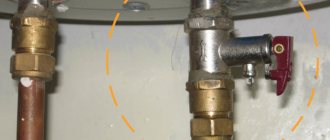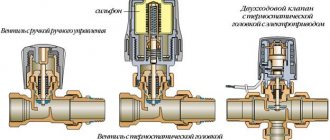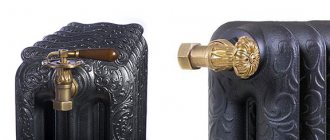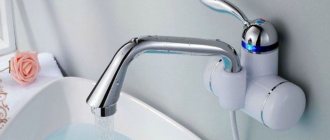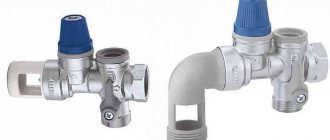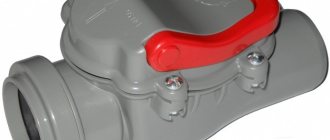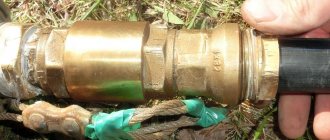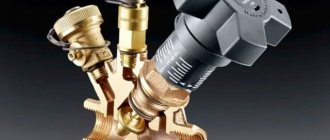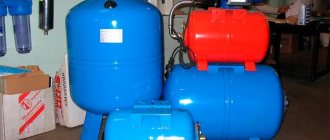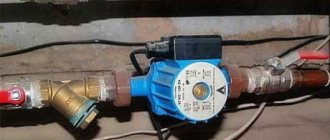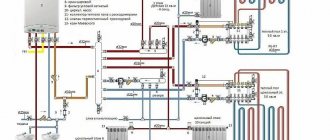What is it needed for
Installing a safety valve prevents the pressure inside the device from increasing above the standard value. What causes blood pressure to rise? As you know, when heated, water expands, increasing in volume. Since the boiler is a sealed device, there is nowhere for the excess to go - the taps are closed, and there is usually a check valve at the supply. Therefore, heating the water leads to an increase in pressure. It may well happen that it exceeds the tensile strength of the device. Then the tank will explode. To prevent this from happening, they install a safety valve for the water heater.
This is what an installed pressure relief valve looks like in a water heater
Maybe there is no need to install a safety valve, but simply remove the non-return valve? At a sufficiently high and stable pressure in the water supply, such a system will work for some time. But the solution is fundamentally wrong, and here’s why: the pressure in the water supply is rarely stable. There are often situations when water barely flows from the tap. Then the hot water from the boiler is forced out into the water supply system. In this case, the heating elements will be exposed. They will heat the air for some time and then burn out.
But burnt-out heating elements are not the worst thing. It’s much worse if they get hot, and at this time the pressure in the water supply rises sharply. The water that gets on the hot heaters evaporates, a sharp increase in pressure occurs - with a jerk - which leads to a guaranteed rupture of the boiler flask. At the same time, a decent volume of scalding water and steam escapes into the room under high pressure. What this could mean is clear.
How does it work
It would be more correct to call a safety valve for a water heater a valve system, since there are two of them in the device.
They are located in a brass or nickel-plated case, which looks like an inverted letter “T” (see photo). At the bottom of the housing there is a check valve that prevents the outflow of water from the water heater when the pressure in the system decreases. In the perpendicular branch there is another valve, which, if the pressure is exceeded, allows some of the water to be released through the fitting.
Safety valve device for boiler
The working mechanism is as follows:
- While the pressure in the boiler is less than that in the water supply (when filling or when the tap is open), the check valve plate is pressed out by the flow of water. As soon as the pressure is equalized, the spring presses the plate against the protrusions of the body, blocking the flow of water.
- When the heating is turned on, the water temperature gradually increases, and with it the pressure also increases. As long as it does not exceed the limit, nothing happens.
- When the threshold level is reached, the pressure compresses the safety valve spring, and the outlet to the fitting opens. Some of the water from the boiler is released through the fitting. When the pressure drops to normal, the spring closes the passage and the water stops flowing.
Based on the principle of operation, it is clear that water will constantly drip from the fitting. This happens when the water heats up and the pressure in the water supply decreases. If you periodically see water on the fitting, then everything is working normally. But the draining liquid must be drained. To do this, put a tube of a suitable diameter on the pipe and secure it with a clamp. The normal operating pressure of the boiler is from 6 Bar to 10 Bar. Without mechanical fastening, the tube will be torn off in no time, so we select a high-quality clamp and tighten it well. Place the tube into the nearest sewer drain.
One more point: the tube for the fitting needs to be transparent and preferably reinforced (the so-called “herringbone”). Why reinforced is understandable - because of pressure, and transparent - to be able to monitor the performance of the device.
How to check serviceability
The installation and regulation characteristics of the safety valve are established by the manufacturer of the water heating equipment.
Sometimes, when purchasing and installing a domestic water heater for hot water supply, owners neglect the manufacturers' intentions and refrain from installing a protective module, arguing that the device interferes with the normal operation of the boiler. Despite the absurdity of such a statement, such cases, although rare, do occur in practice.
The reasons for the unsatisfactory operation of the protective device, due to which the boiler cannot perform its heating functions:
- low consumer quality of materials used in the manufacture of the valve;
- abnormally high pressure in the municipal water supply system over 6 atm.;
- incorrect installation, violations committed during maintenance and adjustment of the valve.
High source water pressure, which interferes with valve operation, mainly occurs in the lower floors of multi-story buildings.
With proper installation, professionals will invariably inquire about the actual pressure readings and install a reduction reducer in front of the boiler. Install the water heater and connect it to a water supply with a pressure of 6 atm. contraindicated.
For high-quality operation of the installed safety device, its functionality must be checked, first when purchased, and then during operation.
When purchasing a valve in a retail chain, it is recommended to check it using a very simple method: you need to press the device’s stem with your finger and blow it with air. If it passes through the valve, then it is better to replace the emergency one with another model.
The valve is checked during operation when malfunctions in its operation are visually noticed. Users should be aware that if the valve in the boiler drips when heating, this is normal and does not mean that it is faulty.
The main reason for undermining the emergency valve when the electric boiler reaches its design capacity is a non-working shut-off plate, which is often clogged with suspended substances falling out of the water, and they need to be removed periodically.
If the flow is strong, then this indicates that it is in a jammed state. In connection with this, not only dismantling and cleaning will be required, but also complete adjustment.
The operation of the check valve functions is checked after the boiler is completely filled. Then close the valve at the entrance to the tank and the central water supply.
At first, water may come out of the electric boiler, this is normal, but the process continues when the tank is heated, then the “return” does not work and the device requires adjustment.
Types and varieties
If we are talking about conventional safety valves for a water heater, then they look almost the same, only the nuances differ. But it is these small details that are responsible for the convenience and safety of operation.
Safety valve for boiler with forced pressure release option
The photo above shows two safety valves with release levers. They are needed for periodic performance checks. The lever flag is lifted up. It pulls the spring behind it, freeing it to release water. This check should be carried out approximately once a month. You can also empty the boiler tank by raising the flag and waiting for everything to drain.
Design Features
The difference in the presented models is that the model in the photo on the left has a lever secured with a screw. This eliminates the possibility of accidental opening and complete discharge of water.
Two more differences are striking. This is an arrow on the body indicating the direction of water movement, and an inscription showing what pressure the device is designed for. Seemingly minor details. But if you can figure out the direction of water movement (look in which direction the poppet valve is turned), then the nominal value is more difficult. How to distinguish, for example, whether it is 6 Bar or 10 Bar? Only checks. How will sellers differentiate them? No way. By boxes. What if they put it in the wrong box? In general, it is better not to take a valve without markings on the body. These are usually the cheapest of the Chinese designs, but the difference in price is not so great that it is worth the risk.
Safety valves - serviceable and not
Also pay attention to the shape of the water discharge fitting. The model on the left has a long fitting and has a non-linear shape. The hose fits on it quite easily and is long enough to install a clamp. The shape of the fitting on the model on the right is different - with an extension towards the end, but more importantly, the fitting is short. You can still pull the hose onto it, but the clamp is questionable. Unless you crimp it with wire...
The following photo shows the safety valves without a forced pressure release flag. The one on the left has a threaded cap at the top. This is a serviceable model. If necessary, you can unscrew the lid to remove clogs, scale and other contaminants.
The model on the right is the worst option. No markings, forced resets or maintenance. These are usually the cheapest available, but this is their only advantage.
For large volume boilers
All of the above models are suitable for water heaters with a volume of up to 50-60 liters. Larger boilers come with other models, many of which have built-in additional devices. Typically this is a ball valve and/or pressure gauge to control pressure.
For boilers up to 200 liters
The water drain fitting here has a standard thread, so there will be no problems with fastening reliability. Such devices already have a fairly high price, but their quality and reliability are much higher.
With pressure gauge and original
Not everyone likes the appearance of these devices. For those who attach great importance to aesthetics, very attractive devices are produced. Their price, however, is comparable to the price of an expensive water heater, but it’s beautiful.
Is it possible to install other valves?
Sometimes, instead of a special safety valve for a boiler, a blast valve is installed, which is intended for the emergency release of heating water. Although their functions are similar, the main mode of operation is fundamentally different. The demolition device should only be used in emergency situations. It is designed for volley discharge of a large volume of liquid. It is not suitable for constantly bleeding small portions of water. Accordingly, it will not work correctly.
Another case is to install only a check valve. It will not allow water to drain when the pressure in the water supply decreases, but it will not save you from increasing pressure in the boiler. So this option doesn't work either.
Installation of other valves
There are cases when, instead of the factory pressure surge protection system, a burst valve is installed on the heater reservoir. It is intended primarily for emergency removal of liquid into the heating system. Although their functionality is largely the same, the basic principle of operation is fundamentally different.
The blast-type valve performs its functions only during an emergency. It is needed to urgently remove all water from the tank. It is not intended for periodic bleeding of small portions of liquid. Considering all this, you should not expect correct functioning from such a craft.
Another example is installing only a check valve. Its mechanism will not allow liquid to drain at low pressure in the system, but it will not be able to save you from sudden surges in the tank. As practice shows, such an assembly is also not functional.
Diagram of all components of safe operation of a water heater
How to choose and install
Select a safety valve for a water heater based on the pressure for which the unit is designed. This number is in the passport. The volume of the tank also influences the choice. They produce devices with operating limits of 6, 7, 8, 10 Bar. Basically, all units are designed for this pressure. So everything is simple here.
Installation is simple: flax tow or fum tape is wound onto the threads, after which the valve is screwed onto the pipe. Twist it all the way by hand, then another one or two turns using keys. It is much more important to choose the right place to install it. When installing a water heater, this valve is installed directly on the cold water inlet pipe.
Installation example
Next there may be a check valve, which is also called a shut-off valve. But this is already reinsurance - the same device is available in the safety device, and often after the water meter at the inlet. The installation diagram is shown below. This is one of the normal options.
Installation diagram of a safety valve for a boiler
The diagram shows a ball valve. It is necessary to empty the tank before storing it for the winter (at dachas) or before dismantling it for prevention and repair. But more often they put it on a tee, which is screwed directly onto the inlet pipe of the water heater. A safety valve is screwed onto the tee from below, and a ball valve is placed in the side outlet.
Installing a safety valve after a tee
Actually, these are all normal options.
How does a safety valve work?
The design of this safety accessory is quite simple. It consists of two perpendicular cylinders of different volumes having a common plane. The larger cylinder has a poppet valve inside, which is pressed by a spring. Thanks to it, water moves in one direction, as with a conventional reverse element. This cylinder is located at the inlet to the water heater and connects it to the pipe that supplies cold water. There are threaded connections on both sides of it.
And the second cylinder has the following characteristics:
- is perpendicular to the main one;
- equipped with a plug on the outside;
- equipped with a small outlet drainage pipe.
There is also a poppet valve inside the small cylinder, but it operates in the direction opposite to the large cylinder.
